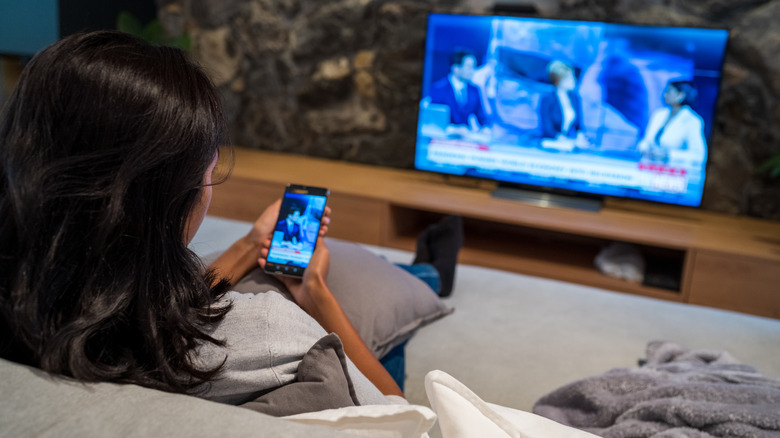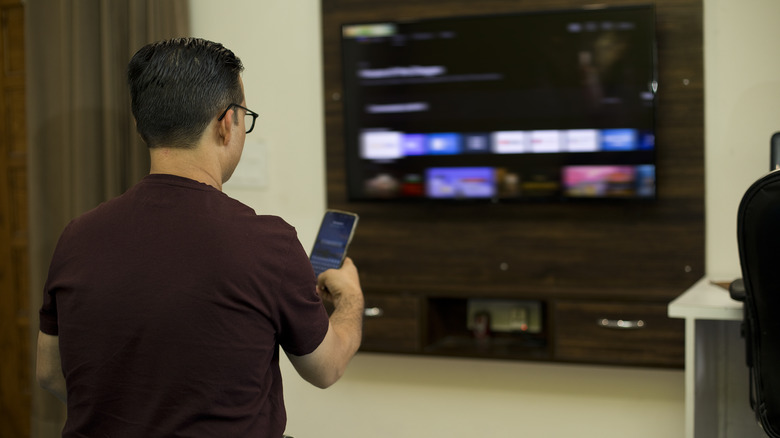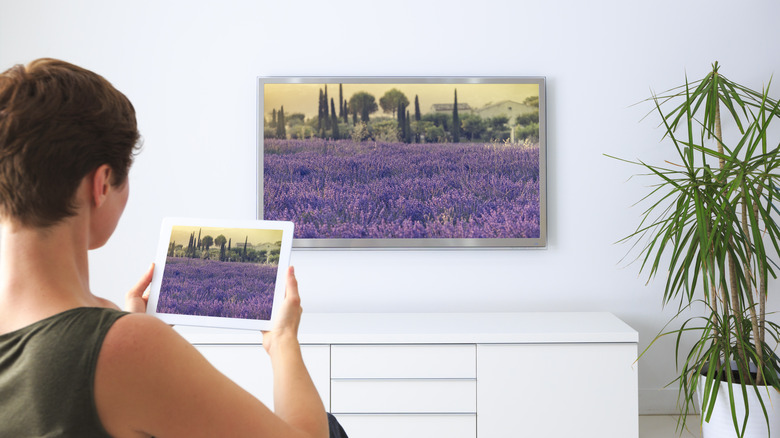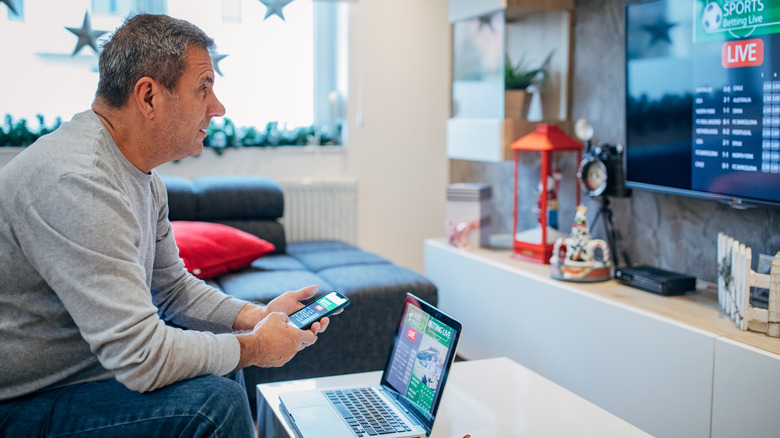What's The Difference Between Screen Mirroring And Casting To A Smart TV?
In the modern world of smartphones, laptops, and smart TVs, being able to share information across multiple screens is no longer a novelty — it's a necessity. Thankfully, many TV models give users the option to transmit visuals from an external display without the need for excessive tangles of wires or dongles. In fact, a sizable swath of smart TVs on the market have compatibility with at least one of the following two features: screen-mirroring or casting from a device.
Some users may believe that screen-mirroring and casting are two interchangeable terms for the exact same process of connecting a smaller screen to a TV. However, that's not quite the case. These two features may be similar and even somewhat linked to one another, but there are a couple of key differences between mirroring and casting a screen that keeps them from being completely synonymous. With that in mind, here is a detailed explanation of both processes, the biggest differences between them, and which is more well-suited for use in a given scenario.
Casting to a smart TV
Casting to a smart TV screen from an external display is a function that is most commonly used with smartphones. Generally speaking, it is accomplished through a wireless connection with both devices running on the same network.
Rather than simply transmitting the phone's screen to the TV, the act of casting is actually when the external device sends the data of a specific piece of media — typically a video of some sort — so that it plays natively on the bigger screen. For this reason, many major media apps on smartphones, such as YouTube and Twitch, include dedicated Cast buttons that can easily identify and connect to smart TV screens. In most cases, casting media will only play it on the smart TV, rather than playing it simultaneously on the external display.
In the past, devices like the Google Chromecast stood as the most elegant way to cast content from an external display to a TV. However, smart TVs and other pieces of tech have come far enough that most have this feature integrated without the need for any peripherals. It's quite a useful option to have, too. For instance, if a certain TV lacks a specific streaming service like Disney+, casting content to the larger screen from a phone with the Disney+ mobile app is a quick and easy workaround.
Screen-mirroring on a smart TV
As opposed to the one-way nature of casting data to a smart TV, screen mirroring is accomplished by a constant, extended linking between the external device and the larger screen. Mirroring is commonly accomplished either through a wired connection between the two devices (typically with an HDMI cable) or a wireless connection.
While casting is mostly used for the sole purpose of sending specific pieces of media over to be played on the TV, screen mirroring is more of a catch-all function for sharing information from an external display. True to its name, it quite literally mirrors — or replicates — the entire display of the sender device so that it appears on the receiver TV. As long as they are paired this way, the TV will continue to display anything happening on the connected device. Most desktop PCs, laptops, and smartphones include built-in ways to mirror their screen via Wi-Fi or Bluetooth, but a wired connection is generally the option that offers the least amount of latency between the two screens.
Screen mirroring is a versatile tool. It is particularly ideal for sharing things like PowerPoint presentations, as users can access and directly control whatever is being displayed on the TV through their smaller device. However, casting is generally still the superior option for displaying media like videos, since data is sent directly to the TV instead of merely replicating an image. As such, some brand-specific features like Apple AirPlay blend the two options by having screen mirroring as the default function and temporarily switching over to a casting setup when selecting a specific piece of media to play.
When to use screen-mirroring instead of casting (and vice-versa)
For those with a device that is capable of both screen-mirroring and casting to smart TVs, there are specific times when it is more beneficial to use one mode over the other. Since mirroring allows users to display just about anything from their external device on the big screen, its use cases are fairly plentiful. This is the feature to use in cases where simply sharing the entire screen of a phone or computer is the desired option, and it allows for things like web pages or mobile entertainment apps to be displayed on a far larger screen than usual. It's also the perfect solution for those who would like to share content on a smart TV but still be able to look at it and control it on the source device.
Casting to a smart TV, on the other hand, is much more limited in scope. It's used for sharing particular pieces of media for viewing on the big screen alone. Nonetheless, as mentioned previously, it is a far better option for transmitting this sort of media than screen mirroring. While smart TVs are technically capable of displaying videos through mirroring, doing it that way potentially introduces issues such as inaccurate colors, audio lag, and a low-quality image. Casting to a smart TV allows the hardware to properly optimize the transmitted media for high-quality playback, making it much closer to a native watching experience.
All in all, there are pros and cons to either setting. Understanding the best times to use screen mirroring and casting respectively can allow users to unlock their smart TV's potential as a powerful display for many of their other devices.



